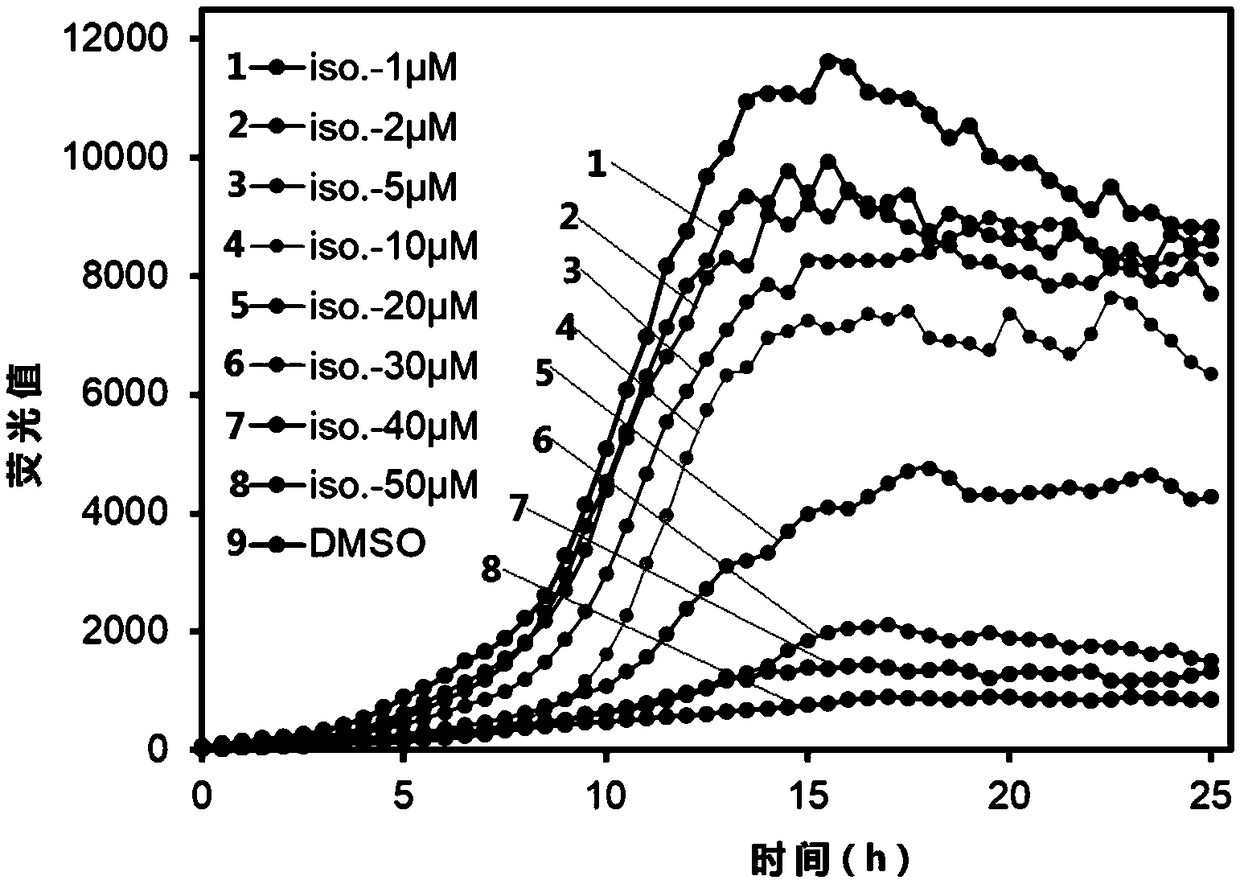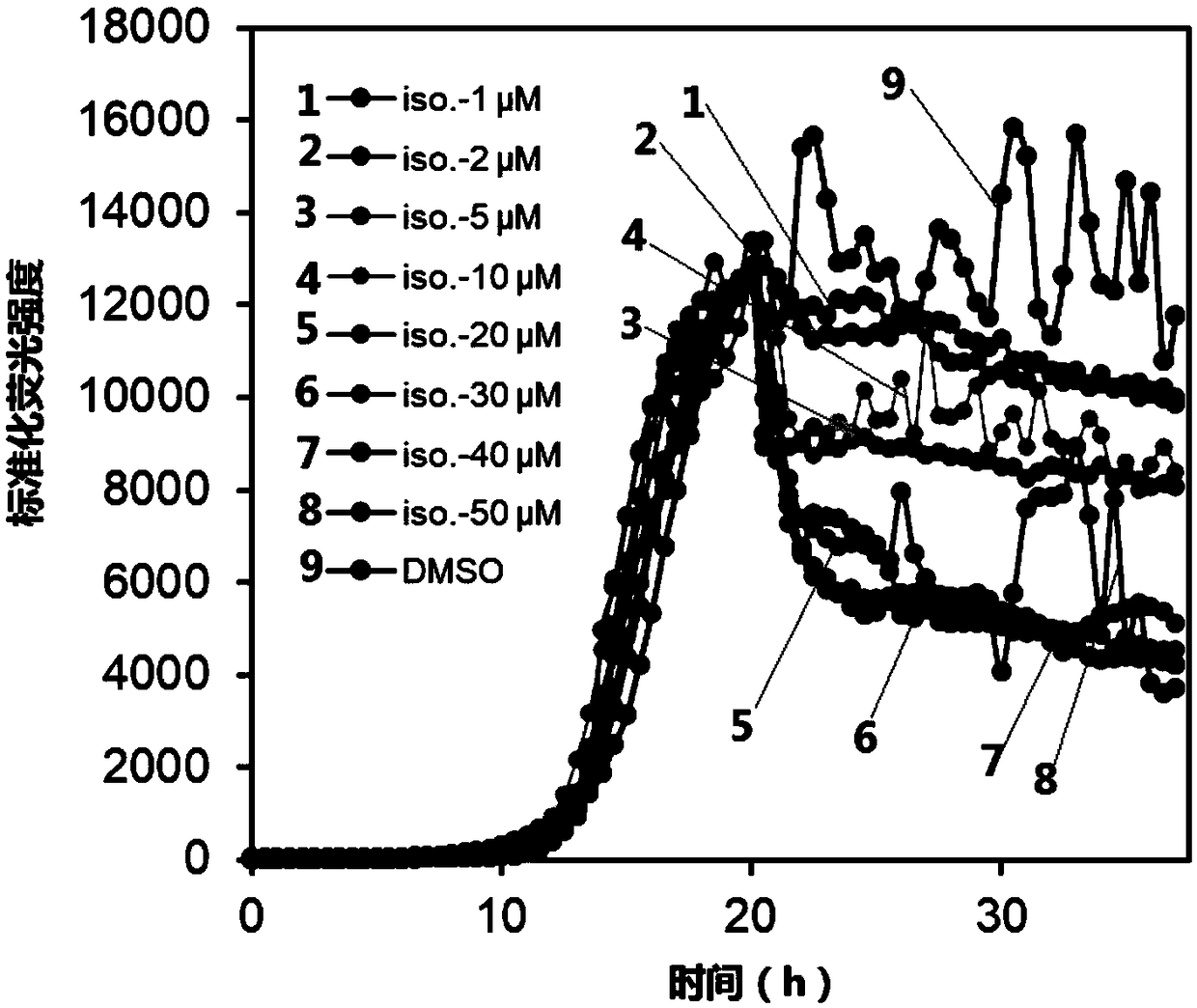Application of psoralen B in inhibiting abnormal aggregation of Tau protein
A psoralen and protein technology, applied in the field of biomedicine, can solve problems such as unsatisfactory drug efficacy, achieve the effects of less toxic and side effects, inhibiting abnormal aggregation of Tau protein, and good curative effect
- Summary
- Abstract
- Description
- Claims
- Application Information
AI Technical Summary
Problems solved by technology
Method used
Image
Examples
Embodiment 1
[0046] Example 1: Inhibitory effect of different concentrations of psoralen on TauK18 protein fibrosis.
[0047] Because heparin sodium induces TauK18 protein to self-aggregate to form fibers. In order to simulate abnormal aggregation of Tau protein in the brain to form neurofibrillary tangles, in this embodiment, TauK18 protein was induced by heparin sodium to form abnormal aggregation to form neurofibrillary tangles. Thioflavin T (ThT) can interact with the β-sheet in the aggregated filaments to generate fluorescence, and its fluorescence intensity is positively correlated with the amount of fiber, which can be used for quantitative analysis of protein fiber amount.
[0048] Method: The purified TauK18 protein freeze-dried product was obtained, weighed accurately, dissolved in Tris-HCl Buffer (pH 7.4), and prepared into a protein mother solution of about 0.56 mg / mL, then quantified with BCA, and recorded the exact concentration. Precisely weigh psoralen B, prepare high-conc...
Embodiment 2
[0057] Example 2: Transmission electron microscope experiment of psoralen B inhibiting TauK18 protein fibrosis
[0058] Methods: The aggregation and fibrosis of TauK18 treated with different concentrations of psoralen B can be visually observed by transmission electron microscopy (TEM), which is a strong evidence for the ThT fluorescence experiment. From the ThT experiment of embodiment 1, collect DMSO control group, low concentration psoralen B group (1 μ M), middle concentration psoralen B group (10 μ M) and high concentration psoralen B group (50 μ M) respectively 5 μL of each sample was diluted and dripped onto the copper grid, and settled for 0.5 hours, then sucked off the excess sample with filter paper, and then dripped 5 μL of 3% uranyl acetate respectively, let it stand for 2 minutes, and then sucked up the excess with filter paper. of uranyl acetate. Place in a transmission electron microscope (NIPPON TEKNO, JEM-1230), observe at an accelerating voltage of 100kV, ta...
Embodiment 3
[0060] Example 3: Depolymerization of TauK18 protein fibers by psoralen B
[0061] Example 3 further verifies that psoralen B has depolymerization effect on TauK18 fibers.
[0062] Methods: Different concentrations of psoralen B were added to the reaction system that had formed fibers, and the depolymerization effect of psoralen B on TauK18 fibers was explored. Around the 19th hour of the fibrosis reaction, the fluorescence intensity reached the maximum, and the degree of TauK18 fibrosis remained basically unchanged. Specifically, according to the construction method of the previous ThT fluorescence experiment in Example 1 (Table 2), when the fluorescence intensity is observed to remain almost unchanged, the detection of the microplate reader is suspended, and 5 μL of different concentrations of psoralen are added to each system. B and an equal volume of DMSO were used as a control, and continued to be placed in a microplate reader at 37°C for 17 hours of constant temperature i...
PUM
 Login to View More
Login to View More Abstract
Description
Claims
Application Information
 Login to View More
Login to View More - Generate Ideas
- Intellectual Property
- Life Sciences
- Materials
- Tech Scout
- Unparalleled Data Quality
- Higher Quality Content
- 60% Fewer Hallucinations
Browse by: Latest US Patents, China's latest patents, Technical Efficacy Thesaurus, Application Domain, Technology Topic, Popular Technical Reports.
© 2025 PatSnap. All rights reserved.Legal|Privacy policy|Modern Slavery Act Transparency Statement|Sitemap|About US| Contact US: help@patsnap.com



